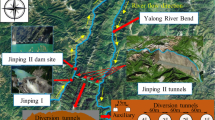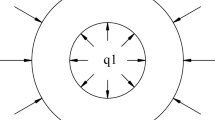Abstract
Knowledge of the degree and depth of the excavation damaged zone (EDZ) resulting from drill-and-blast excavations has important influences on the design and construction of deep underground tunnels. However, the spatial distribution of EDZ around underground tunnels subjected to the combined effect of blast loading and in situ stress unloading is still under discussion. In this study, the dependences of the spatial distribution of EDZ in an underground tunnel on the variations of in situ stress conditions, excavation dimensions and rock strength were investigated using a combined method of field measuring and numerical modelling. Field measurements of EDZ in an underground mine were first conducted using the non-metallic acoustic technique. Subsequently, a blast excavation model concerning the combined effect of blast loading and in situ stress unloading was developed and calibrated against the field-measured data. Finally, the EDZs induced by various in situ stress conditions, tunnel shapes, and dimensions as well as rock strengths were simulated. The field measurement results indicate that larger highly damaged zones are generated at the roadway crown and sidewall, whereas smaller intensively damaged zones are induced at the roadway shoulder. The average depth of EDZ around the tested roadways, with an overburden of 355 m to 915 m, varies from 0.36 m to 1.72 m. The numerical results show that in situ stress, excavation dimension, and rock strengths significantly impact the depth of EDZ. More specifically, lateral pressure coefficient and the shape of the roadway cross section play a predominant role in controlling the distribution pattern of EDZ, and the magnitude of in situ stress, excavation dimension, and rock strength mainly contribute to the depth of EDZ. Furthermore, the special phenomenon of zonal disintegration in the surrounding rock mass occurs around highly pre-stressed underground roadways.




















Similar content being viewed by others
Data Availability
Available by the authors.
References
Borrvall T (2011) The RHT concrete model in LS-DYNA, 8th European LS-DYNA conference
Cai M, Kaiser PK (2005) Assessment of excavation damaged zone using a micromechanics model. Tunn Undergr Space Technol 20(4):301–310. https://doi.org/10.1016/j.tust.2004.12.002
Cao WZ, Li XB, Tao M et al (2016) Vibrations induced by high initial stress release during underground excavations. Tunn Undergr Space Technol 53:78–95. https://doi.org/10.1016/j.tust.2016.01.017
Cheng RS, Zhou ZL, Chen WS et al (2022) Effects of axial air deck on blast-induced ground vibration. Rock Mech Rock Eng 55(2):1037–1053. https://doi.org/10.1007/s00603-021-02676-9
Diederichs MS (2007) The 2003 Canadian geotechnical colloquium: mechanistic interpretation and practical application of damage and spalling prediction criteria for deep tunnelling. Can Geotech J 44(9):1082–1116. https://doi.org/10.1139/T07-033
Fan Y, Zheng JW, Cui XZ et al (2021) Damage zones induced by in situ stress unloading during excavation of diversion tunnels for the Jinping II hydropower project. Bull Eng Geol Environ 80(6):4689–4715. https://doi.org/10.1007/s10064-021-02172-y
Han HY, Fukuda D, Liu HY et al (2020) Combined finite-discrete element modelling of rock fracture and fragmentation induced by contour blasting during tunnelling with high horizontal in-situ stress. Int J Rock Mech Min Sci 127:104214. https://doi.org/10.1016/j.ijrmms.2020.104214
Kaiser PK, Yazici S, Maloney S (2001) Mining-induced stress change and consequences of stress path on excavation stability — a case study. Int J Rock Mech Min Sci 38(2):167–180. https://doi.org/10.1016/S1365-1609(00)00038-1
Li HB, Xia X, Li JC et al (2011) Rock damage control in bedrock blasting excavation for a nuclear power plant. Int J Rock Mech Min Sci 48(2):210–218. https://doi.org/10.1016/j.ijrmms.2010.11.016
Li SJ, Feng XT, Li ZH et al (2012) Evolution of fractures in the excavation damaged zone of a deeply buried tunnel during TBM construction. Int J Rock Mech Min Sci 55:125–138. https://doi.org/10.1016/j.ijrmms.2012.07.004
Li XB, Cao WZ, Zhou ZL et al (2014) Influence of stress path on excavation unloading response. Tunn Undergr Space Technol 42:237–246. https://doi.org/10.1016/j.tust.2014.03.002
Li XB, Li CJ, Cao WZ et al (2018) Dynamic stress concentration and energy evolution of deep-buried tunnels under blasting loads. Int J Rock Mech Min Sci 104:131–146. https://doi.org/10.1016/j.ijrmms.2018.02.018
Li XH, Zhu ZM, Wang M et al (2021) Numerical study on the behavior of blasting in deep rock masses. Tunn Undergr Space Technol 113:103968. https://doi.org/10.1016/j.tust.2021.103968
Liu KW, Li XD, Hao H et al (2019) Study on the raising technique using one blast based on the combination of long-hole presplitting and vertical crater retreat multiple-deck shots. Int J Rock Mech Min Sci 113:41–58. https://doi.org/10.1016/j.ijrmms.2018.11.012
Liu KW, Yang JC, Li XB et al (2018) Study on the long-hole raising technique using one blast based on vertical crater retreat multiple deck shots. Int J Rock Mech Min Sci 109:52–67. https://doi.org/10.1016/j.ijrmms.2018.06.020
Lu WB, Yang JH, Yan P et al (2012) Dynamic response of rock mass induced by the transient release of in-situ stress. Int J Rock Mech Min Sci 53:129–141. https://doi.org/10.1016/j.ijrmms.2012.05.001
Ma GW, An XM (2008) Numerical simulation of blasting-induced rock fractures. Int J Rock Mech Min Sci 45(6):966–975. https://doi.org/10.1016/j.ijrmms.2007.12.002
Martino JB, Chandler NA (2004) Excavation-induced damage studies at the Underground research laboratory. Int J Rock Mech Min Sci 41(8):1413–1426. https://doi.org/10.1016/j.ijrmms.2004.09.010
Mortazavi A, Molladavoodi H (2012) A numerical investigation of brittle rock damage model in deep underground openings. Eng Fract Mech 90:101–120. https://doi.org/10.1016/j.engfracmech.2012.04.024
Pellet F, Roosefid M, Deleruyelle F (2009) On the 3D numerical modelling of the time-dependent development of the damage zone around underground galleries during and after excavation. Tunn Undergr Space Technol 24(6):665–674. https://doi.org/10.1016/j.tust.2009.07.002
Qian QH, Zhou XP, Yang HQ et al (2009) Zonal disintegration of surrounding rock mass around the diversion tunnels in Jinping II Hydropower Station. Southwestern China Theor Appl Fract Mech 51(2):129–138. https://doi.org/10.1016/j.tafmec.2009.04.006
Qiu XY, Hao YF, Shi XZ et al (2018) Numerical simulation of stress wave interaction in short-delay blasting with a single free surface. PLoS ONE 13(9):e0204166. https://doi.org/10.1371/journal.pone.0204166
Sengani F (2020) The use of ground penetrating radar to distinguish between seismic and non-seismic hazards in hard rock mining. Tunn Undergr Space Technol 103:103470. https://doi.org/10.1016/j.tust.2020.103470
Shao JF, Jia Y, Kondo D et al (2006) A coupled elastoplastic damage model for semi-brittle materials and extension to unsaturated conditions. Mech Mater 38(3):218–232. https://doi.org/10.1016/j.mechmat.2005.07.002
Souley M, Renaud V, Al Heib M et al (2018) Numerical investigation of the development of the excavation damaged zone around a deep polymetallic ore mine. Int J Rock Mech Min Sci 106:165–175. https://doi.org/10.1016/j.ijrmms.2018.04.028
Sun QH, Ma FS, Guo J et al (2021) Excavation-induced deformation and damage evolution of deep tunnels based on a realistic stress path. Comput Geotech 129:103843. https://doi.org/10.1016/j.compgeo.2020.103843
Tao M, Hong ZX, Peng K et al (2019) Evaluation of excavation-damaged zone around underground tunnels by theoretical calculation and field test methods. Energies 12(9):1682. https://doi.org/10.3390/en12091682
Wang H, Jiang Y, Xue S et al (2015) Assessment of excavation damaged zone around roadways under dynamic pressure induced by an active mining process. Int J Rock Mech Min Sci 77:265–277. https://doi.org/10.1016/j.ijrmms.2015.03.032
Williams M, Ziegler M, Schennen S et al (2022) Evolution of excavation damaged zones in Opalinus clay shale inferred from seismic investigations. Eng Geol 299:106528. https://doi.org/10.1016/j.enggeo.2022.106528
Wu G, Zhang L (2004) Studying unloading failure characteristics of a rock mass using the disturbed state concept. Int J Rock Mech Min Sci 41:419–425. https://doi.org/10.1016/j.ijrmms.2004.03.077
Yan P, Lu WB, Chen M et al (2015) Contributions of in-situ stress transient redistribution to blasting excavation damage zone of deep tunnels. Rock Mech Rock Eng 48(2):715–726. https://doi.org/10.1007/s00603-014-0571-3
Yang JH, Dai JH, Yao C et al (2020) Estimation of rock mass properties in excavation damage zones of rock slopes based on the Hoek-Brown criterion and acoustic testing. Int J Rock Mech Min Sci 126: 104192. https://doi.org/10.1016/j.ijrmms.2019.104192
Yang JH, Jiang QH, Zhang QB et al (2018) Dynamic stress adjustment and rock damage during blasting excavation in a deep-buried circular tunnel. Tunn Undergr Space Technol 71:591–604. https://doi.org/10.1016/j.tust.2017.10.010
Yang JH, Yao C, Jiang QH et al (2017) 2D numerical analysis of rock damage induced by dynamic in-situ stress redistribution and blast loading in underground blasting excavation. Tunn Undergr Space Technol 70:221–232. https://doi.org/10.1016/j.tust.2017.08.007
Yi CP, Nordlund E, Zhang P et al (2021) Numerical modeling for a simulated rockburst experiment using LS-DYNA. Undergr Space 6(2):153–162. https://doi.org/10.1016/j.undsp.2019.11.002
Yilmaz O, Unlu T (2013) Three dimensional numerical rock damage analysis under blasting load. Tunn Undergr Space Technol 38:266–278. https://doi.org/10.1016/j.tust.2013.07.007
Zhang J, Liu WY, Zhu QZ et al (2022) A novel elastic–plastic damage model for rock materials considering micro-structural degradation due to cyclic fatigue. Int J Plast 103496. https://doi.org/10.1016/j.ijplas.2022.103496
Zhao HT, Tao M, Li XB et al (2019) Estimation of spalling strength of sandstone under different pre-confining pressure by experiment and numerical simulation. Int J Impact Eng 133:103359. https://doi.org/10.1016/j.ijimpeng.2019.103359
Zhu QZ, Kondo D, Shao J (2009) Homogenization-based analysis of anisotropic damage in brittle materials with unilateral effect and interactions between microcracks. Int J Numer Anal Methods Geomech 33(6):749–772. https://doi.org/10.1002/nag.741
Zhu WC, Wei J, Zhao J et al (2014) 2D numerical simulation on excavation damaged zone induced by dynamic stress redistribution. Tunn Undergr Space Technol 43:315–326. https://doi.org/10.1016/j.tust.2014.05.023
Acknowledgements
The authors would like to thank all the supporter.
Funding
The research presented in this paper was jointly supported by the National Natural Science Foundation of China (Grant No. 12072376) and the Fundamental Research Funds for the Central Universities of Central South University (2021XQLH053).
Author information
Authors and Affiliations
Corresponding author
Ethics declarations
Conflict of interest
The authors declare no competing interests.
Rights and permissions
Springer Nature or its licensor (e.g. a society or other partner) holds exclusive rights to this article under a publishing agreement with the author(s) or other rightsholder(s); author self-archiving of the accepted manuscript version of this article is solely governed by the terms of such publishing agreement and applicable law.
About this article
Cite this article
Hong, Z., Tao, M., Wu, C. et al. The spatial distribution of excavation damaged zone around underground roadways during blasting excavation. Bull Eng Geol Environ 82, 155 (2023). https://doi.org/10.1007/s10064-023-03114-6
Received:
Accepted:
Published:
DOI: https://doi.org/10.1007/s10064-023-03114-6




